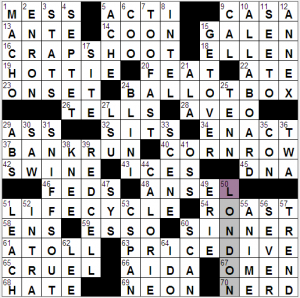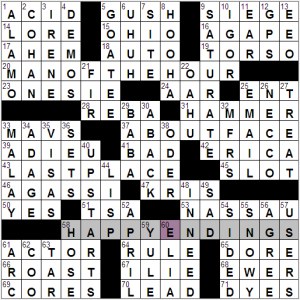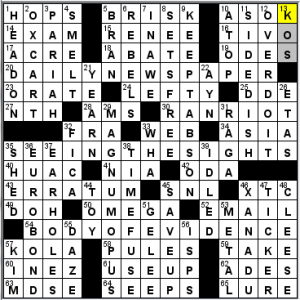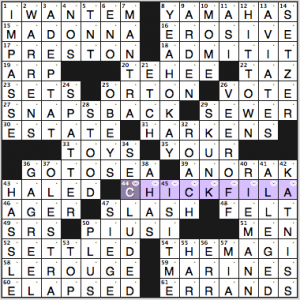NYT 3:41 (pannonica)
LAT 3:20 (pannonica)
CS 11:31 (Sam)
BEQ untimed
Lynn Lempel’s New York Times crossword — pannonica’s review
Experience with crosswords has primed me to look for completeness, tidy themes. That, along with hastiness, worked against me in this puzzle because I misled myself into expecting too much from it and getting all tantalized. Tell you about it after the run-down.
- 50d. [2012 Olympics locale, with a hint to the ends of the answers to the six starred clues] LONDON.
- 16a. [*Big gamble] CRAP SHOOT.
- 24a. [*Election day receptacle] BALLOT BOX.
- 37a. [*Result of a financial panic] BANK RUN.
- 40a. [*Tight braid] CORNROW.
- 51a. [*Series of changes from birth to death] LIFE CYCLE. This is more the lay sense than the biological type that first occurs to me. Briefly, it’s the sequence from inception (e.g., fertilization) through reproductive maturity. This should not be interpreted as a dismissal of senescence.
- 63a. [*Precipitous drop in cost] PRICE DIVE. The second expressly economic term among the them answers. Combined with the political 24a and the existential connotations of 16a and 51a, it leaves 40a CORNROW as feeling the odd one out.
The ends of those answers are of course categories of Olympic sports endeavor: shooting, boxing, running, rowing, cycling, and diving.
So, what I did was I naturally allied 50d with its symmetrical partner 4d [Two trios plus one] SEPTET. I failed to notice that there was no direction to link this answer to the theme. Further, I didn’t read the clue for LONDON past “… hint to the ends …” so I was uninformed that there were only six starred clues (and didn’t bother to count during the solve). With these oversights—and the inescapable media coverage, especially over the weekend—I assumed that there were seven events, and further assumed that they would be the components of the heptathlon. Women’s: 100m hurdles, high jump, shot put, 200m, long jump, javelin throw, 800m. Men’s: 60m, long jump, shot put, high jump, 60m hurdles, pole vault, 1000m. Not that I was familiar enough with the parts for it to to have helped during solving, even if I had used that strategy, or if that was the theme (which it wasn’t, as I believe I’ve mentioned).
The seemingly requisite Two Long Verticals (that’s how these puzzles often shake out, with themers running across, the need for flow in the grid, and (I assume) a desire for the constructor to provide variety and a little extra bang-for-buck) are a train conductor’s ALL ABOARD and the scenthound-clued SNIFFS OUT. Slightly shorter are TOO FAST and CALORIES in Column Eight. Interesting that the crossword-natural Chevrolet AVEO (manufactured 2002–2011) has only appeared three times in NYT puzzles (2007, 2011, and 2012).
The remainder of the puzzle has the expected early-week mix of easygoing clues and unspectacular fill, which means it hits the mark for a Monday.
Marti DuGuay-Carpenter’s Los Angeles Times crossword — pannonica’s review
58-across is the theme revealer for this puzzle: [Fairy tale outcomes, or, in a way, what the last words of 20-, 37-, and 43-Across are] HAPPY ENDINGS. Two points: (1) I’m contractually obligated to make the observation that such an answer would certainly be clued differently in one of the edgier venues such as the Onion, or Brendan Emmet Quigley’s site. (2) in the unrevised and darker earlier versions, many if not most classic fairy tales did not have happy endings. See the critical writings of Jack Zipes, Maria Tatar, Bruno Bettleheim, and Marie-Louise von Franz (disclosure: I haven’t read all of those authors). Which reminds me, there was a recent modern anthology edited by Kate Bernheimer that I intend to get ahold of.
- 20a. [Guy for whom glasses are raised] MAN OF THE HOUR (happy hour).
- 37a. [One-eighty] ABOUT FACE (happy face). What, no [Uey] clue?
- 43a. [The cellar, sports-wise] LAST PLACE (happy place).
 Yes, well, happy hour is the only one of those three I can really get behind. The others are a little too self-helpy for my liking. Hm, come to think of it, so is happy hour, although perhaps it’s more self-medicinal. Nevertheless, it’s more to my taste. And, it doesn’t rhyme with those other two smugsters.
Yes, well, happy hour is the only one of those three I can really get behind. The others are a little too self-helpy for my liking. Hm, come to think of it, so is happy hour, although perhaps it’s more self-medicinal. Nevertheless, it’s more to my taste. And, it doesn’t rhyme with those other two smugsters.
Stuff:
- Row one provides an unpleasant narrative: ACID | GUSH | SIEGE. No, thank you.
- Crosswordese rivers: AAR & ODER. Bit tough for an early-weeker, but the crossings keep them honest.
- 56d [Shake on it] AGREE. With the A–––– in place, thought it was A DEAL; happy that it wasn’t that partial.
- Longish non-theme fill: SATURATE, UPSTARTS.
- Little-known fact: ENTs such as [Tolkien’s Treebeard, for one] can diagnose resinous post-nasal drip.
- 5d [Colonel Sanders trademark] GOATEE. But perhaps they should update the image to a gallinaceous mohawk rather than a caprine beard?
Good puzzle, modest theme. Typical Monday.
Bob Klahn’s CrosSynergy/Washington Post crossword, “Double Headers” – Sam Donaldson’s review
Well, the easiest thing about this puzzle was guessing its constructor. And that’s good, because this is Day 6 of Name That Constructor Month. I was so sure this was a Bob Klahn puzzle that I didn’t even bother to think of anyone else for my other two guesses. If I owned a farm, I would have bet it too. No one else would have a puzzle with so many twisty clues.
The theme was simple enough. The three longest Across answers are all common terms beginning with a word that can also precede “double.” Thus, each of those lead-in words is also a “double header:”
- 20-Across: The [Popular place for a puzzle] is the DAILY NEWSPAPER. Fans of parimutual wagering, Jeopardy!, and parimutual wagering on Jeopardy! are all familiar with the “daily double.”
- 35-Across: One who is [Taking a tour] is SEEING THE SIGHTS. But one who spends too long on the activity may well be “seeing double” before the day is over.
- 54-Across: [Fodder for the jury] is the BODY OF EVIDENCE it must weigh in its deliberations. Interestingly, a common alibi used by criminal defendants is that the offensive conduct was committed by a “body double.” (Okay, so it’s not common. I’m trying to make some smooth segues here, people, and it ain’t always easy.)
Two 14s and a 15 make for 43 theme squares, so that gives Bob lots of room for jazzy fill. I liked OVERDO IT, KEEP TABS ON, MAGNUM OPUS, EURO BOND, HEAD-ON, SAVE UP, and USE UP, though it occurs to me now as I type out this list that there’s an awful lot of prepositions in this grid. There’s no limit to the number of prepositions one can have in a grid, of course (were I to set a number, 14 feels about right), but the double occurrences of UP and ON is highly unusual.
I can always count on a Bon Klahn puzzle to teach me something I don’t think I ever knew. Today it was GELEE, the [Sticky styling stuff]. Is that–is that the formal name for hair gel?
As mentioned, the signature feature of a Bob Klahn puzzle is the host of trikcy clues. Here were some of my favorites: [Mathematics degree?] for NTH, [She’s “born again,” literally] for RENEE (re-nee!), [This could be a lot] for an ACRE, and [Cereal for regular people?] for BRAN. Talk about a clue that passes the breakfast test!
Brendan Quigley’s blog crossword, “Themeless Monday”
My favorite clue today is the winkingly meta 50a: [First of 12 popes (just put the Roman numeral in now and get the name from the crossings)]. Somebody I. Working crossings… ah, PIUS I. Joon would know if there are other pope names that have been used 12 times but most of us wouldn’t have the foggiest idea.
Other highlights:
- The lively entries “ADMIT IT,” CHICK-FIL-A, THE MAGI, “YEAH, OKAY,” HIT TOWN, VEER OFF, GAG REEL, and KATNISS.
- 37d. [Food additive that was included in Time’s 50 Worst Inventions], OLESTRA. Is there any other food additive that can come close? I say no.
- 51a. [Entire “Glengarry Glen Ross” cast, e.g.], MEN. Good movie/play, but it completely flunks the Bechdel Test. And it’s a good clue.
Lows: “I WANT ‘EM” feels contrived to me. TEHEE seems to live only in crosswords and dictionaries (I prefer tee-hee; also, please do not ever type “hehe” to represent laughter). 43a: [Ordered to go into court], HALED—archaic verb. AGER isn’t really a noun anyone uses outside crosswors, is it? ADEPT AT lacks the in-the-languaginess of VEER OFF.
3.75 stars.




I think the best thing about the theme is the switch in meaning of the theme related words from noun to verb.
Favorite answer: HOTTIE..
pannonnica, I feel compelled to clear up some heptathlon confusion for you.
The events you listed for the women are correct.
The events you listed for the men are correct if it were for an *indoor* heptahlon, something contested in the winter, and in particular, not in the oympics.
Outdoors and in the olympics, then men contest the decathlon, which does not, for the record, have any kind of 60m race nor a 1000m race.
I hope any ill will you’ve accrued from me by my pushing this unsolicited information on you is well-balanced by the more complete athletics fan I hope you can now be.
Thanks Jared, I simply lifted the lists from the Wikipedia entry, and Wikipedia as we know is not always the best or most authoritative resource (but it’s oh-so convenient). It does explain, however, why I was surprised to see that there was a men’s version; I’d thought the women’s heptathlon was the analog to the decathlon. (I only know these sports via the Olympics.)
Huda, I didn’t notice the shifts from noun to verb, but even being aware of them now, I don’t feel it’s so significant or impressive. The meanings don’t change much, by my reckoning, for shoot, run, or dive. Then again, perhaps I’m being defensive.
Pannonica, I agree that it’s not much of a wow factor. I simply appreciated the consistency, but I too noted the fact that sometimes the meaning shifted significantly: e.g. for BOX from a containing to a sport, and in other cases not much. Your idea for a theme would have been much more powerful, even if the clue for the revealer would have had to be adjusted. But I think it probably would have moved it to a Tuesday intricacy level.
I think of Monday’s goal as (often) being something along the lines of: Have you noticed this weird little thing about the English language? That things rhyme, that there are homonyms, that a single vowel can change and transform a meaning, that the same word can be a verb or a noun, etc.. The latter is remarkable to me because in other languages (e.g. in Arabic) that would never be allowed. The written word might look the same, but the accents on it (written or implied) would always differentiate the word’s function. The fact that in English a verb and a noun from the same family can be totally identical is such a common trick to mislead you in the cluing– it’s nice to see it flipped and used as a theme…
Sorry, I always get carried away re language comparisons. It’s interesting to see how much uncertainty languages do or do not tolerate.
Can’t seem to edit… I meant e.g. for BOX from a containER to a sport,
Didn’t even realize the sports hidden in the theme answers.
BTW, can anyone tell me why it is that you see recurring words/answers in puzzles from different papers and places on the same day or so?
RK, it’s simply a cognitive bias. A fancy name is Baader-Meinhof Phenomenon, but it’s also called “frequency illusion” or “recency illusion.” In other words, mostly coincidence.
Huda – you might want to look at Crossword Fiend on Feb 22, 2012, when we were talking about words in English that can be different parts of speech. Good times!
Pan, et. al.,
Are you familiar with the book *Randomness – The Drunkard’s Walk* by Leonard Mlodinow (sp?)? HIGHLY recommended, although some topics (e.g. Bayes’ Theorem) I have seen more clearly treated elsewhere.
gosh, i absolutely loved the NYT theme—it was inch-perfect to me. timely, of course, but also elegantly executed. if she’d tried to work with heptathlon (or decathlon) verbs, it’d basically be run, throw, jump, run some more, throw some more, jump some more, and run some more. not very fun.
amy, off the top of my head i can’t think of another pope name used exactly 12 times. pius XII was the pope during WWII, so those are easier to remember… but when i test-solved this puzzle, i had the U in place anyway before i saw the clue.
@pannonica Just read about the Baader-Meinhof Phenomenon. Interesting. I’ll post back if I can prove the recurrences I see aren’t an illusion.
RK et al,
The Baader-Meinhof phenomenon is part of our drive to connect the dots, interpret patterns, and any sort of salience (recency, personal significance) enhances that. I remember being pregnant and thinking the number of pregnant women had risen dramatically…
http://www.youtube.com/watch?v=RFgtGIL7vEY
If you have a moment, you may wish to watch this piece about a split brain patient. And listen to the part about the Bell and the music. It’s a great demonstration of our need to make plausible stories. (And the studies are classic in their own right, of course).
Bruce: I have heard of this book, but never read it. You have now motivated me to look for it.
Loren, I’ll look it up! You guys are keeping me busy!
I think Joon once crunched the numbers to calculate the odds of a given crossword answer appearing in more than one puzzle in close proximity. The upshot was: These random things happen. It means nothing.
Amy, that’s a good brief summary of the book I referenced, though of course it has a lot more detail and texture.
Some of you may recall that Jim Thorpe won both the pentathlon and the decathlon in the 1912 games. He was later disqualified because he was a professional. In the ancient games, the pentathlon consisted of the javelin, discus, long jump, a foot race and wrestling. This event was last contested by men in about 1924. The pentathlon for women was contested from 1964 until 1980. In 1984, it was changed to the Heptathlon.
The modern pentathlon is an entirely different event and you can see it on
Aug.11. It is a test of military skills required of 19th century soldiers: fencing, swimming, cross country run, pistol shooting and equestrian show jumping.
Steve
coffee’s for closers.
Wait, both TOO FAST and CALORIES in the middle column? That would make for an asymmetrical 16-row grid (or a possibly symmetrical grid of the even rarer 16×16 or 14×16 size)… Ah, it’s a typo: singular CALORIE.
Since I study the biology of addiction and mood for a living, I need to fight the impulse of going on for too long, since Amy may feel that this is beyond puzzle-relatedness…
In a nutshell, one of the coolest things about the brain is that it’s in the business of constant remodeling, albeit within limits. Every time we learn something, we are doing a bit of remodeling. Which means that experience, events in our real life, thoughts and feelings (positive or negative) all have a biological impact on brain structure and function. Drugs of course, such as cocaine and alcohol, but also antidepressants, affect brain structure and function. So, in mild cases of psychiatic ormaddictive problems, e.g. Minor depression, it’s possible to use behavioral strategies to reverse an insipient illness. There does come a point where the biological changes are so profound that they are hard to reverse behaviorally, and drug treatment, or a combination of drugs and altered behavior are required to contain the problem.
I think an additional component in addiction is understanding the triggers of relapse. We have studies the biology of that particular issue, and it’s evident that for some people these triggers are incredibly powerful. It’s like you could not see a Starbucks sign without having an irresistible urge for a latte. So, people need to find tricks to fight the constant reminders. Addiction is a series of habits of mind, and these habits need to be reprogrammed, behavior whatever means. So, I have a very integrative view if behavioral and biological strategies, because I know that the brain will take both types of information and work with it. Of course people temd to polarize or project all kinds of philosophies onto all of that. It’s because a very biological take seems rather stark to them, although I personally believe it’s most humane, because it’s completely non-judgemental.
Sorry… Amy.. Too long.
Seeing the occasional repeated word in a non-related crossword isn’t unusual. Two years ago, I doubt ADMEN was ever seen (no, I didn’t look it up). Now it occurs weekly. But that’s not an example, because it has increased in pop culture usage, probably due to a TV show. Neither do crosswordese examples like EWER or SNL raise an eyebrow if they they happen to occur in several places.
But seeing a series of relatively obscure (or not recently seen) words repeated on the same or following day across different venues isn’t a brain function. It’s an observation, and thus exists. The question then, would be the mechanism that creates this anomaly.
I don’t think it is a function of word lists from auto-fill apps. But I don’t know what else could cause it.